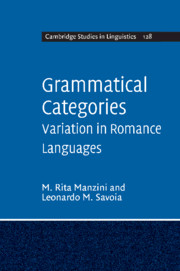Book contents
- Frontmatter
- Contents
- List of tables
- Acknowledgements
- Introduction: grammatical categories and the biolinguistic perspective
- 1 The structure and interpretation of (Romance) complementizers
- 2 Variation in Romance k-complementizer systems
- 3 Sentential negation: adverbs
- 4 Sentential negation: clitics
- 5 The middle-passive voice: evidence from Albanian
- 6 The auxiliary: have/be alternations in the perfect
- 7 The noun (phrase): agreement, case and definiteness in an Albanian variety
- 8 (Definite) denotation and case in Romance: history and variation
- Notes
- References
- Index
Introduction: grammatical categories and the biolinguistic perspective
Published online by Cambridge University Press: 11 April 2011
- Frontmatter
- Contents
- List of tables
- Acknowledgements
- Introduction: grammatical categories and the biolinguistic perspective
- 1 The structure and interpretation of (Romance) complementizers
- 2 Variation in Romance k-complementizer systems
- 3 Sentential negation: adverbs
- 4 Sentential negation: clitics
- 5 The middle-passive voice: evidence from Albanian
- 6 The auxiliary: have/be alternations in the perfect
- 7 The noun (phrase): agreement, case and definiteness in an Albanian variety
- 8 (Definite) denotation and case in Romance: history and variation
- Notes
- References
- Index
Summary
According to Chomsky (2000b: 119), ‘the human language faculty and the (I–)languages that are manifestations of it qualify as natural objects’. This approach – which ‘regards the language faculty as an “organ of the body”’ – has been labelled the ‘biolinguistic perspective’ by Chomsky (2005: 1). Hauser, Chomsky and Fitch (2002: 1570) base their discussion of the key biological question of evolution on the ‘biologically and individually grounded’ use of the term language ‘to refer to an internal component of the mind/brain (sometimes called “internal language” or “I-language”)’. They distinguish two conceptions of the faculty of language, one broader (FLB) and one narrower (FLN):
FLB includes FLN combined with at least two other organism-internal systems, which we call ‘sensory-motor’ and ‘conceptual-intentional’ … A key component of FLN is a computational system (narrow syntax) that generates internal representations and maps them into the sensory-motor interface by the phonological system and into the conceptual-intentional interface by the (formal) semantics system … Most, if not all, of FLB is based on mechanisms shared with nonhuman animals … FLN – the computational mechanism of recursion – is recently evolved and unique to our species.
(Hauser, Chomsky and Fitch 2002: 1571)The conception of the language faculty and of (I-)languages as ‘natural’, ‘biologically grounded’ objects corresponds to specific theories concerning their internal articulation:
the I-language consists of a computational procedure and a lexicon. The lexicon is a collection of items, each a complex of properties (called ‘features’) … The computational procedure maps an array of lexical choices into a pair of symbolic objects, phonetic form and LF [logical form] … The elements of these symbolic objects can be called ‘phonetic’ and ‘semantic’ features, respectively, but we should bear in mind that all of this is pure syntax and completely internalist.
(Chomsky 2000b: 120)Information
- Type
- Chapter
- Information
- Grammatical CategoriesVariation in Romance Languages, pp. 1 - 12Publisher: Cambridge University PressPrint publication year: 2011
